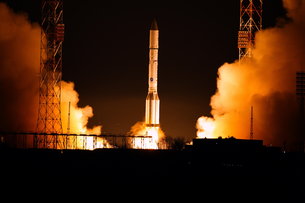The European Data Relay System’s first laser terminal has reached space aboard its host satellite and is now under way to its final operating position.
EDRS-A was launched on 29 January as part of the Eutelsat-9B telecom satellite at 22:20 GMT (23:20 CET, 04:20 30 January local time) atop a Proton rocket from Baikonur, Kazakhstan.
The satellite was released at 07:32 GMT today, around 36 000 km over the equator, and is now moving towards its final geostationary position at 9°E over Europe, where it will be operated by Eutelsat.
EDRS is ESA’s most ambitious telecom programme yet, taking the form of a public–private partnership between ESA and Airbus Defence and Space, with Airbus operating the service and the DLR German Space Administration funding the development of the laser terminal.
Dubbed the ‘SpaceDataHighway’, EDRS will revolutionise satcoms as Europe’s first optical communication network, capable of relaying user data in near-real time at an unprecedented 1.8 Gbit/s.
Normally, low-orbiting satellites must come within view of a ground station before they can send their information to Earth.
EDRS instead collects their information from its higher, geo-stationary position via laser and immediately relays it to the ground, dramatically improving access to time-critical and potentially life-saving data.
ESA, Airbus and DLR will in a few days begin testing EDRS-A’s general health and performance, working with the EDRS ground stations in Germany, Belgium and the UK.
Test links to its first customers, the European Commission’s Copernicus Sentinel satellites, will then be carried out over several weeks for the service to begin this summer. Data relay for the International Space Station will start in 2018.
featured: EDRS-A liftoff























